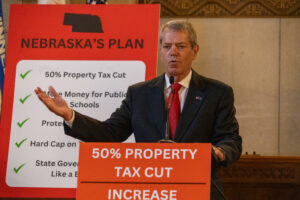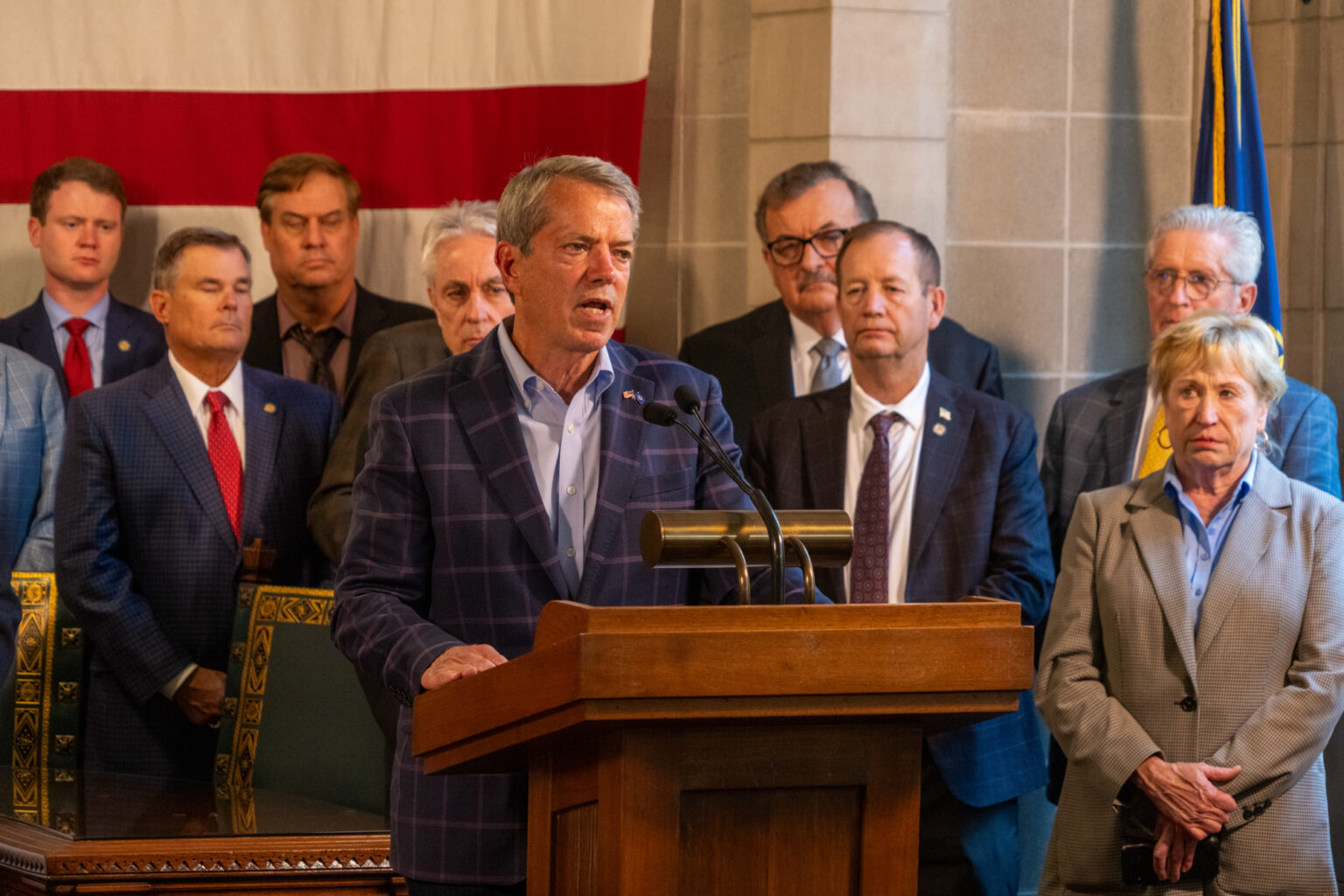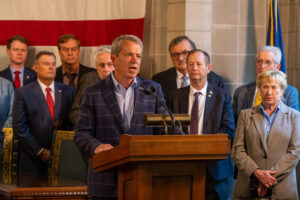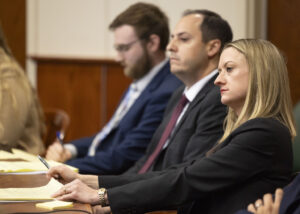by Zach Wendling, Nebraska Examiner
November 8, 2024
LINCOLN — Gov. Jim Pillen is officially calling on Nebraska lawmakers to address “inconsistencies” in the state’s main school aid formula in the 2025 legislative session.
Pillen, in a Friday news release, pointed to a new report from his policy research office that compiled property tax data for new state senators. The governor noted that newly elected senators — with 16 fresh faces set to join the body in January — might not have a complete understanding of the state’s funding formula, or the impact of recent legislation.

The report includes data from Nebraska’s 244 school districts in the previous school year and indicates how decreases in state aid led to property tax increases.
“This document helps illustrate the impact of those changes and, hopefully, [will] inform discussions as we embark on the next legislative session and resume efforts to provide additional property tax relief to Nebraskans,” Pillen said in a statement.
TEEOSA breakdown
The conversation revolves around the Tax Equity and Educational Opportunities Support Act, better known as TEEOSA, which has been perennially updated since its adoption in 1990.
TEEOSA, also known as the “equalization aid” formula, determines funding aid based on the difference of about 18 “needs” minus six “resources” for each public school district. If “resources” outweigh “needs,” the district doesn’t receive the aid and is classified as “unequalized.”
“Needs” include student growth, poverty and English as a second language. “Resources” include net option enrollment, allocated income tax funds and base aid per student. These are the various components that make up the “resources” and “needs” that amount to “equalization aid” as part of the Tax Equity and Educational Opportunities Support Act (TEEOSA). (Courtesy of the Nebraska Department of Education)
Another “resource” is based on possible property tax collections, assuming a $1 hypothetical tax rate across each school district. This is the amount the state assumes a district could raise if it had that high of a tax rate, based on annual valuations.
This means when valuations go up, a district’s equalization aid automatically goes down, possibly to the point they are “unequalized” and lose the extra funding.
Finding stability
For example, Lincoln Public Schools, the state’s second largest district, is likely to be unequalized in the coming years. LPS lost $31.85 million in state aid this year, a decrease of 30.4%, and raised property taxes by $31.57 million in response, a 9.6% increase.
Three other school districts — Millard Public Schools, Papillion-La Vista Public Schools and Gretna Public Schools — also saw “dramatic drops in state aid.” Combined with LPS, the four districts lost $56.27 million in state aid and increased property taxes by $62.25 million. That accounts for 82% of the total increase in property taxes statewide for that period. State Sens. Lou Ann Linehan of Elkhorn and Tom Brandt of Plymouth meet at the front of the legislative chamber near Clerk of the Legislature Brandon Metzler. Aug. 17, 2024. (Zach Wendling/Nebraska Examiner)
Kenny Zoeller, director of the governor’s policy research office, said state aid decreased for 111 school districts for the 2024-25 school year.
“We need to find a way to better help districts budget for the aid they do get, thereby creating some predictability and, hopefully, further reduce what Nebraskans end up paying in property taxes year over year,” Zoeller said in a statement.
Pillen and Zoeller do not explain how to provide more stability. However, they state that initial research indicates newly placed soft “caps” on how much school districts can increase their property taxes slowed total increases to 2.5%, or about $75.82 million.
That’s the smallest annual increase since 2018 and the smallest percentage increase this century.
‘They’re on pins and needles’
Multiple state lawmakers proposed addressing TEEOSA in the Pillen-led special session on property taxes this summer, including State Sens. Lou Ann Linehan of Elkhorn and Jana Hughes of Seward.
Linehan, the Legislature’s outgoing Revenue Committee chair, called for eliminating the “resources” side of the funding formula, to better calculate each district’s needs. She later proposed using TEEOSA to distribute increased sales and “sin” tax revenue to districts for property tax relief. Linehan is term-limited and won’t return next year.

Hughes, a former school board member in Seward, worked with a bipartisan group of lawmakers on a proposal to reform TEEOSA over 10 years, or sooner if possible. Her proposal would have decreased maximum school property tax rates gradually over 10 years.
Pillen had proposed having the state take over nearly all local operational property taxes, which account for an average of 60% of Nebraskans’ property tax bills. However, when Linehan introduced Pillen’s core proposal, it did not include that component.
Hughes said she agrees TEEOSA needs to be a focus but thinks it will take time and an in-depth look, such as what happened when TEEOSA was first created, with the Revenue and Education Committees collaborating on the proposal, and relying on years of research and design.
“I get this sense from schools right now, every year they’re on pins and needles of what is going to change or what is the legislative body going to do?” Hughes said.
‘The formula is inconsistent’
In 2023, the Legislature helped to increase aid to schools by doubling special education reimbursements from 40% of expenditures to 80% and set a baseline “foundation aid,” about $1,500 per student in each public school district.
Hughes said some school districts “hunker down” and ask residents to invest through property taxes to prevent budget cuts or to react to uncertainty of whether future funds will be available.
“It’s just a little vicious cycle a bit when valuations go up,” Hughes said. State Sen. Brad von Gillern of Elkhorn, center. Aug. 20, 2024. (Zach Wendling/Nebraska Examiner)
State Sen. Brad von Gillern of Elkhorn, vice chair of the Legislature’s Revenue Committee, said he hadn’t yet digested the report but agreed with its main findings. He said he’s aware of people encouraging a reconsideration of TEEOSA and is “supportive of a thoughtful and patient process that includes all stakeholders, to improve the state funding calculation.”
Hughes said she and a team of lawmakers will return with a 2025 proposal that will be smaller but still “take a little bite” out of reforming TEEOSA.
Pillen has requested that lawmakers consider similar legislation.
“The formula is inconsistent and hits taxpayers hard,” the policy research office report states. “It is not fair to them or the schools. Providing certainty to school districts will allow Nebraska to have sustained property tax reductions for the first time in history.”
GET THE MORNING HEADLINES.
SUBSCRIBE
Nebraska Examiner is part of States Newsroom, a nonprofit news network supported by grants and a coalition of donors as a 501c(3) public charity. Nebraska Examiner maintains editorial independence. Contact Editor Cate Folsom for questions: info@nebraskaexaminer.com. Follow Nebraska Examiner on Facebook and X.











